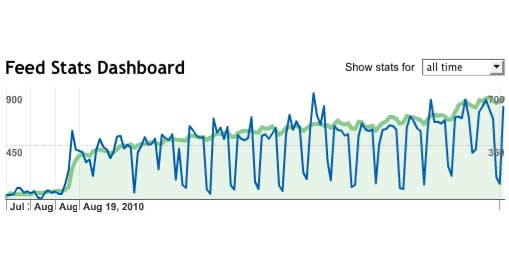Above are the Feedburner stats for Mimi & Eunice. The green line represents subscribers; the blue represents “reach” (“the total number of people who have taken action — viewed or clicked — on the content in your feed”). The lines represent an overall trend of linear growth. Not exponential growth. Which is fine, but makes me wonder: is “viral” (exponential) sharing becoming a thing of the past, as quality content on the internet becomes more ubiquitous?
A few years ago, if you put anything halfway decent online it would spread like a virus. The online memosphere was less colonized than it is today. Of course there will still be “viral” content, but it has a lot more to compete with today: all the other viral content. Imagine if you released something of today’s quality online 10 years ago. It would have spread further and faster back then, because attention wasn’t already consumed by vast amounts of other quality content. On the other hand, the internet itself was much smaller 10 years ago – fewer people had access to it – so overall reach of a viral success could have been lower in absolute terms.
I’ve noticed the linear trend in most of my works now (sitasingstheblues.com, having enjoyed exponential growth followed by a plateau, is now on a linear decline). Maybe this means my work sucks, but I don’t think so. I’m happy with linear growth. But I am revising my ideas about “viral content,” and I wonder if others are, too. Twitter’s “Trending: Worldwide” lists indicate some things spread virally – suddenly they’re everywhere – but then they’re gone the next day, and forgotten in a week.
What does this all mean? Does it mean anything? As an artist, should I care?



I’d forget viral and focus more on the “1000 True Fans” concept, which you seem to be doing well at already. It’s ultimately easier (and less sleazy) to ask 1000 of your closest fans for $100 bucks each than it is to ask 100,000 random people for a dollar.
I had the good fortune to do a Flash game project for a client that went viral, so I saw firsthand how quickly that awareness comes and goes and, more importantly, how poorly viral awareness converts to money or action.
There’s a palpable desperation in those who strive for mainstream level awareness constantly, where everything has to go viral or else it’s considered a failure. It’s just not worth it.
Love the blog but when are you doing another film?!
Viral doesn’t mean good, nor does it mean people like your work. Continuous visitors are far more important in my opinion, people who come back day after day.
Have you ever heard of Jeffrey Gitomer? He’s a sales trainer and the author of the book, ‘Customer Satisfaction is Worthless, Customer Loyalty is Priceless’ in which he points out how much of a difference there is between ‘loyal’ customers/fans and ‘satisfied’ customers/fans. The trick of course is to turn satisfied into loyal, because if you can increase the number of loyal fans, you are increasing your sales base.
Wayne
Dear Nina,
NO. You shouldn’t care. I agree with Bwkthbm and the M. H. entirely. And if you ever want to test this “1000 true fans” concept (all these ideas are new to me !…), go ahead, try me & put me down on the list for a modest, steady, linear pebble. In euros !
In business terms you call this a product life cycle for the reason you are seeing a decline. I feel you are right on many levels. The internet entertainment industry is over saturated. This causes it to be harder to be viral; however those that do go viral really get a huge number of views because market size (# of viewers) is huge. Taking advantage of the market you already have is a tried and true option. The old saying goes that “80% of your sales are from 20% of your clientsâ€. Utilizing your fan base by giving them products they want is better than wasting all your energy chasing new audience members.
The internet is a new world and is constantly changing. I feel the current trend for those artists that want to be free to utilize the internet in order to be financially liberated from a larger company (employer) is to constantly test different revenue streams, record the results, asses the numbers, and react.